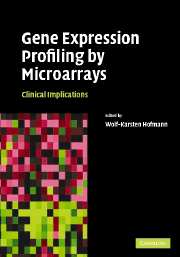Book contents
- Frontmatter
- Contents
- List of contributors
- Foreword
- Introduction
- 1 Technique of microarrays: microarray platforms
- 2 Quantitative quality control of microarray experiments: toward accurate gene expression measurements
- 3 Statistical analysis of gene expression data
- 4 Genomic stratification in patients with heart failure
- 5 Gene expression profiling for the diagnosis of acute leukemias
- 6 Gene expression profiling can distinguish tumor subclasses of breast carcinomas
- 7 Gene expression profiling in lymphoid malignancies
- 8 mRNA profiling of pancreatic beta-cells: investigating mechanisms of diabetes
- 9 Prediction of response and resistance to treatment by gene expression profiling
- Index
- References
8 - mRNA profiling of pancreatic beta-cells: investigating mechanisms of diabetes
Published online by Cambridge University Press: 05 September 2009
- Frontmatter
- Contents
- List of contributors
- Foreword
- Introduction
- 1 Technique of microarrays: microarray platforms
- 2 Quantitative quality control of microarray experiments: toward accurate gene expression measurements
- 3 Statistical analysis of gene expression data
- 4 Genomic stratification in patients with heart failure
- 5 Gene expression profiling for the diagnosis of acute leukemias
- 6 Gene expression profiling can distinguish tumor subclasses of breast carcinomas
- 7 Gene expression profiling in lymphoid malignancies
- 8 mRNA profiling of pancreatic beta-cells: investigating mechanisms of diabetes
- 9 Prediction of response and resistance to treatment by gene expression profiling
- Index
- References
Summary
The pancreatic beta-cell in health and disease
Diabetes is one of the most common health problems of our age, affecting more than 150 million patients worldwide today and perhaps will affect twice as many a few decades on from now [1]. In the vast majority of patients, the exact cause of their disease state is unknown. Diabetes can be caused by autoimmune destruction of insulin-producing beta-cells in the pancreas (type 1 diabetes) or by a failure of the beta-cells to produce/release insulin in sufficient amounts to meet the metabolic demand (type 2 diabetes). The latter group represents about 90% of all diabetic patients and today is one of the most prevalent existing health problems. The high prevalence, chronic nature, and unknown cause of diabetes are strong arguments for studying the beta-cell in order to identify mechanisms by which beta-cells are destroyed or made dysfunctional.
Identification of key aspects of beta-cell dysfunction at the molecular detail requires that the molecules in the normal beta-cell, as well as their mode of action, are known. The rationale to build up such knowledge in a biomedical context is dual. First, it is expected that such insight will assist in the process of finding new ways of drug treatment for type 2 patients, so that beta-cell dysfunction can be corrected in a more efficient way than is possible today. Second, this type of knowledge will define the endpoint of investigations that aim to generate new beta-cells from pancreatic or extra-pancreatic precursor cells.
- Type
- Chapter
- Information
- Gene Expression Profiling by MicroarraysClinical Implications, pp. 187 - 211Publisher: Cambridge University PressPrint publication year: 2006
References
- 2
- Cited by



